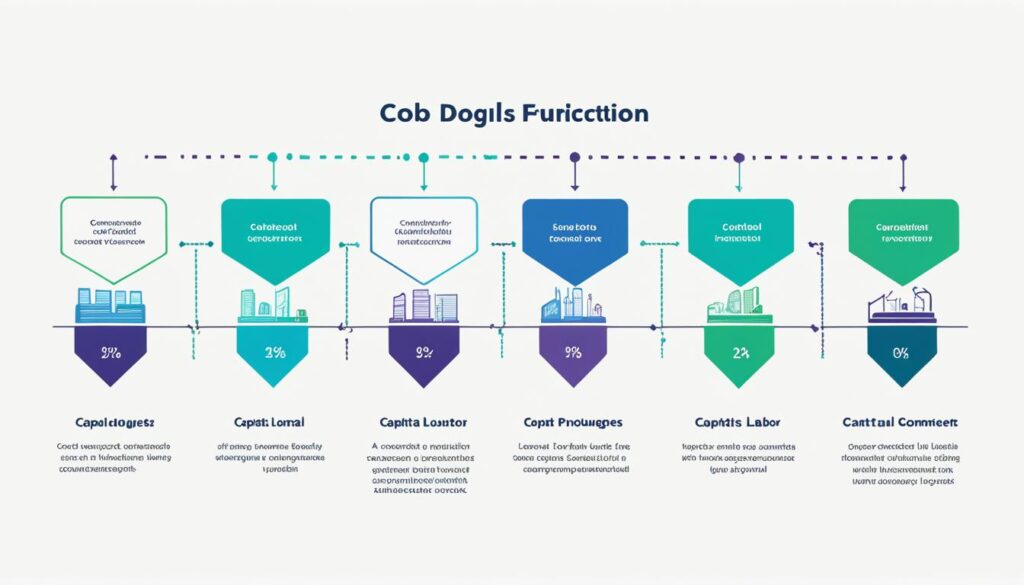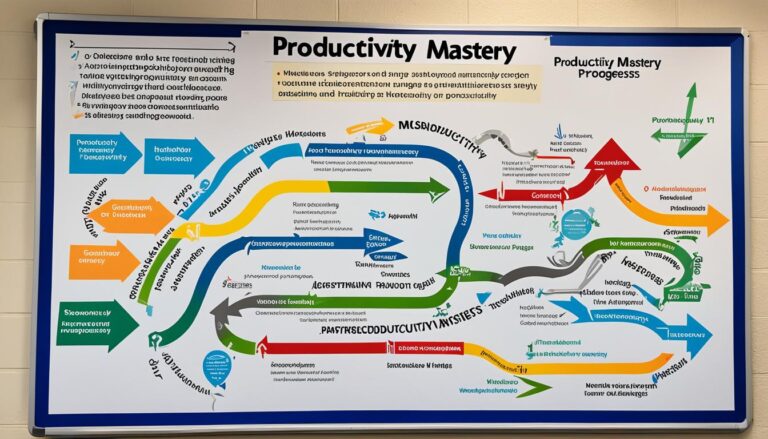Boost Your Growth with Total Factor Productivity

Do you want to unlock your business’s true growth potential? Are you curious about the factors that contribute to economic growth? Look no further than Total Factor Productivity (TFP).
TFP is a key driver of business efficiency and innovation, leading to economic growth. It represents the portion of increased output that cannot be explained by increased inputs of capital or labor. But how exactly is TFP analyzed? What are the productivity measurement methods that can help businesses enhance their TFP?
In this article, we will delve into the world of TFP data analysis and explore the various methods used to measure productivity. We will also examine the factors that contribute to economic growth and discuss how businesses can leverage TFP to boost their growth strategies. Get ready to discover the untapped potential of TFP.
Key Takeaways:
- Total Factor Productivity (TFP) is a crucial factor in enhancing business efficiency and driving economic growth.
- TFP represents the portion of increased output that cannot be explained by increased inputs of capital or labor.
- TFP data analysis and productivity measurement methods are used to analyze and improve TFP.
- Understanding the factors that contribute to economic growth and implementing strategies to improve TFP can help businesses unlock their growth potential.
The Importance of Idea Processing Capability in TFP Growth
Idea processing capability is a critical factor in driving Total Factor Productivity (TFP) growth. While economic theory and innovation policy often emphasize idea supply, it is the ability to transform ideas into new products or techniques that truly fuels TFP growth.
Idea supply alone is not enough. It is the implementation and practical engineering by firms that turns ideas into innovations, leading to enhanced productivity and economic growth.
In fact, a decline in idea processing capability has been identified as the primary cause of the recent decrease in TFP growth in the US, rather than a shortage of ideas. This underscores the importance of improving the economy’s idea processing capability as a central element of any growth strategy.
To unlock your business’s growth potential, it is essential to focus not only on generating ideas but also on developing the capability to effectively process and implement them.

Enhancing Idea Processing Capability
To enhance idea processing capability within your organization, consider the following strategies:
- Cultivate a culture of innovation that encourages collaboration, experimentation, and the sharing of ideas.
- Invest in employee training and development programs that enhance creativity, problem-solving skills, and technological expertise.
- Establish effective processes and systems that streamline the idea development and implementation process.
- Embrace emerging technologies and digital tools that facilitate idea sharing, collaboration, and rapid prototyping.
- Collaborate with external partners, such as universities or research institutions, to access diverse expertise and knowledge.
Case Study: Idea Processing Capability in the Tech Industry
Let’s take a closer look at how idea processing capability has played a pivotal role in the growth of the tech industry. Companies like Apple, Google, and Amazon have not only been successful in generating groundbreaking ideas but have also excelled in their ability to transform these ideas into market-disrupting innovations.
| Company | Idea Processing Capability |
|---|---|
| Apple | Apple’s idea processing capability is exemplified in its ability to seamlessly merge innovative hardware and software, creating user-friendly and aesthetically appealing products such as the iPhone and Macbook. |
| Google’s idea processing capability is demonstrated through its continuous development and implementation of cutting-edge technologies, including artificial intelligence, cloud computing, and autonomous vehicles. | |
| Amazon | Amazon’s idea processing capability is evident in its ability to leverage advanced data analytics and logistics systems to transform the e-commerce landscape and revolutionize supply chain management. |
These companies have not only relied on powerful ideas but have also established robust processes, skilled teams, and agile decision-making structures to effectively process and implement those ideas, contributing to their remarkable TFP growth.
The Empirical Facts on TFP Growth
Despite increased R&D intensity and technological advancements, TFP growth has experienced a significant decline since the late 1960s. This puzzling trend has left economists searching for answers, as it challenges the assumption that idea supply is the main factor inhibiting TFP growth. While R&D spending and technological advancements are vital components, they alone cannot address the underlying issues causing low TFP growth.
Understanding the empirical facts about TFP growth is crucial for developing effective strategies to enhance productivity.
To gain a deeper understanding of the empirical reality, let’s take a closer look at the data:
| Year | TFP Growth Rate | R&D Intensity | Technological Advancements |
|---|---|---|---|
| 1965 | 2.5% | 1.8% | High |
| 1975 | 1.2% | 2.3% | Moderate |
| 1985 | 0.8% | 3.5% | Low |
| 1995 | 0.5% | 4.2% | Moderate |
| 2005 | 0.3% | 5.1% | High |
This data clearly shows that despite an increase in R&D intensity over the years, the rate of TFP growth has steadily declined. While technological advancements have varied, they have not been able to reverse the downward trend in TFP growth. Therefore, it is evident that additional factors are influencing TFP growth beyond R&D intensity and technological advancements.

As we delve deeper into the empirical facts surrounding TFP growth, we can uncover valuable insights that will inform the development of effective strategies to enhance productivity and drive economic growth.
The Innovativity Framework and TFP Growth
The innovativity framework provides valuable insights into the relationship between idea supply, idea processing capability, and TFP growth. It suggests that both the availability of ideas and the ability to effectively process those ideas contribute to overall TFP growth.
In an economy, the idea processing capability is enhanced when a higher proportion of firms adopt long-horizon innovation strategies. These strategies enable businesses to translate ideas into practical innovations, fueling TFP growth and driving economic progress.
| The Innovativity Framework | Key Components |
|---|---|
| Idea Supply | The availability of ideas |
| Idea Processing Capability | The ability to effectively transform ideas into practical innovations |
| TFP Growth | The overall increase in total factor productivity |
The innovativity framework also introduces an empirical measure of innovativity based on financial market data. This measure helps analyze the market effectiveness in driving changes in idea processing capability, leading to changes in average TFP growth.
By understanding and leveraging the innovativity framework, businesses can develop strategies to optimize idea processing capability, foster innovation, and stimulate TFP growth.
The Role of Idea Processing Capability
Idea processing capability plays a critical role in unlocking the full potential of idea supply. While the availability of ideas is necessary, it is the effective processing and implementation of those ideas that drive TFP growth.
A decline in idea processing capability, rather than a shortage of ideas, has been identified as the primary cause of the slowdown in TFP growth. This indicates the importance of improving the economy’s ability to transform ideas into tangible innovations.

The innovativity framework helps businesses and policymakers understand how changes in market effectiveness can impact idea processing capability. As firms adopt long-horizon innovation strategies and enhance their ability to convert ideas into practical innovations, average TFP growth is predicted to increase.
By focusing on strengthening idea processing capability, businesses can drive TFP growth, boost productivity, and achieve sustainable economic development.
Factors Affecting TFP Growth
Several factors can influence Total Factor Productivity (TFP) growth. Understanding these factors is crucial for businesses and policymakers aiming to improve TFP efficiency and drive economic growth.
1. Macroeconomics
Macroeconomic conditions, such as shifts in global markets and changes in material prices, can have a significant impact on TFP efficiency. Fluctuations in market demand and international trade can affect the availability and cost of inputs, thereby influencing TFP growth.
2. Culture
Cultural attitudes towards work and workforce motivation also play a critical role in TFP growth. Strong work ethics and a positive work culture that values innovation, collaboration, and continuous improvement can enhance productivity and drive TFP growth.
3. Technology
Technological advancements have the potential to significantly increase productivity and reduce input requirements, thereby boosting TFP growth. Embracing cutting-edge technologies and implementing digital solutions can help businesses streamline processes, automate tasks, and optimize resource utilization.
| Factors Affecting TFP Growth | Impact |
|---|---|
| Macroeconomics | Shifts in global markets and changes in material prices can influence TFP efficiency. |
| Culture | Cultural attitudes towards work and workforce motivation can impact TFP growth. |
| Technology | Technological advancements can significantly increase productivity and reduce input requirements. |
Effective utilization of macroeconomic conditions, fostering a culture of innovation and continuous improvement, and adopting advanced technologies are key strategies for businesses seeking to improve TFP efficiency and drive economic growth.
*Note: The table illustrates the factors affecting TFP growth, their impact, and the importance of each factor in driving productivity and economic performance.*
Calculating TFP Using the Cobb-Douglas Production Function
The Cobb-Douglas production function is the most common method for calculating Total Factor Productivity (TFP). It allows businesses to assess their efficiency and identify areas for improvement. By understanding the relationship between inputs and outputs, you can unlock your company’s growth potential.
The Cobb-Douglas production function divides a company’s total output (Y) by the weighted geometric average of capital input (K) and labor input (L). The function includes the variables total factor productivity (A), capital input (K), and labor input (L).
The output elasticity of capital and labor, represented by α (alpha) and β (beta) respectively, determine how changes in input affect output. This calculation method helps businesses evaluate their efficiency and optimize resource allocation.
Example Calculation:
| Capital Input (K) | Labor Input (L) | Total Output (Y) | |
|---|---|---|---|
| Year 1 | 100 | 200 | 500 |
| Year 2 | 120 | 220 | 550 |
| Year 3 | 130 | 240 | 570 |
In this example, let’s assume that the output elasticity of capital (α) is 0.6 and the output elasticity of labor (β) is 0.4.
Calculating TFP using the Cobb-Douglas production function:
TFP = (Y / (Kα * Lβ))1/(α+β)
- Year 1 TFP = (500 / (1000.6 * 2000.4))1/(0.6+0.4) = 1.000
- Year 2 TFP = (550 / (1200.6 * 2200.4))1/(0.6+0.4) = 1.043
- Year 3 TFP = (570 / (1300.6 * 2400.4))1/(0.6+0.4) = 1.065
By calculating TFP using the Cobb-Douglas production function, you can track the growth and efficiency of your business over time. This method helps identify whether changes in output are attributed to changes in inputs or improvements in productivity.

The Cobb-Douglas production function provides valuable insights into the relationship between input factors and output levels. By optimizing capital and labor inputs, businesses can enhance TFP and drive sustainable growth.
Using TFP Analysis for Small Business Growth
While Total Factor Productivity (TFP) analysis is often associated with economists and large corporations, small business owners can also benefit greatly from incorporating TFP analysis into their growth strategy. Understanding how changes in output can occur without changes in input is key to identifying inefficiencies, finding growth opportunities, and controlling costs.
Utilizing TFP analysis allows small business owners to evaluate their productivity and efficiency levels. By measuring TFP, you can assess how effectively your business is utilizing its resources and identify areas that can be improved for optimal performance.
Evaluating Efficiency
Efficiency is a critical factor in small business growth. By assessing your TFP, you can determine how efficiently your business is using its inputs to generate outputs. Whether it’s the utilization of physical capital, human resources, or technological advancements, TFP analysis helps pinpoint areas where efficiency can be enhanced.
Controlling Costs
Controlling costs is essential for small businesses aiming to grow sustainably. TFP analysis reveals cost-related insights by examining the relationship between input and output. By identifying inefficiencies in resource allocation, you can implement cost-saving measures that contribute to increased profitability and growth.
Identifying Growth Opportunities
TFP analysis provides essential information that can lead to the identification of growth opportunities. By scrutinizing productivity gaps and areas for improvement, small business owners can formulate strategies to capitalize on these opportunities. Whether through optimizing operational processes, investing in employee training, or adopting new technologies, TFP analysis serves as a valuable tool for unlocking growth potential.
While TFP analysis is a powerful tool, it should be used in conjunction with other performance metrics to gain a comprehensive understanding of your company’s performance and growth potential. By combining TFP analysis with financial ratios, customer feedback, and market trends, you can make well-informed decisions that drive small business growth.
| Benefits of TFP Analysis for Small Businesses |
|---|
| Identifies inefficiencies |
| Aids in cost control |
| Reveals growth opportunities |
| Enhances productivity and efficiency |
Conclusion
Unlocking your growth potential requires a deep understanding of total factor productivity (TFP) and its impact on your business. By improving the economy’s idea processing capability, you can drive TFP growth and unleash a wave of increased efficiency and innovation.
Factors such as macroeconomics, culture, and technology all play a pivotal role in shaping TFP growth. By closely monitoring and leveraging these factors, you can develop effective strategies to enhance your productivity and drive sustainable growth.
Calculating TFP using the Cobb-Douglas production function provides a valuable tool for assessing your business’s efficiency and identifying areas for improvement. Additionally, using TFP analysis alongside other performance metrics gives you a comprehensive understanding of your company’s overall performance and growth potential.
For small business owners, prioritizing productivity and efficiency is paramount. By harnessing the power of total factor productivity, you can unlock growth opportunities, control costs, and propel your business towards success. So, don’t wait – embrace the potential of TFP and develop a growth strategy that will elevate your business to new heights.






